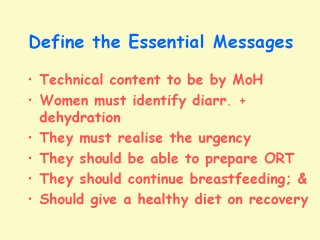| front |1 |2 |3 |4 |5 |6 |7 |8 |9 |10 |11 |12 |13 |14 |15 |16 |17 |18 |19 |review |
 |
The fewer/simpler
the messages, the more likely they are to be remembered when they are needed.
Too many messages cause confusion which can be even more dangerous than
having only minimal information. This can make for some tensions with the
MoH where professionals will want to give all the information. Here, using
priority messages to achieve fewer than seven (often said to be the maximum
for any one intervention), was considered the optimum way to proceed. Most women that we spoke to were well able to define the signs of dehydration (fast, shallow breathing, sunken eyes, sunken fontanel, raging thirst, and inelastic skin when pinched). Not always was vomiting associated with dehydration. We were unable to establish what degree of urgency was attached to bouts of diarrhoea – beyond the panic that sets in when the baby goes comatose. It was thus assumed that emphasis should be placed on treating all cases of diarrhoea with urgency. Preparation of the ORT in the home proved challenging. First, the policy of Government was solely to promote the use of the ‘packet’. While this would give a good ratio of the ingredients if the volume of water to which it was added was accurate, no account was taken of the fact that 99% of women in Baluchestan couldn’t read the instructions on the (1 litre) packet; and there were in any event two other packets available – one for half-a-litre, and one for 125 ml. Obviously, this was a recipe for total confusion. We thus opted for the home solution after testing to see how women in the province would handle it; selecting the pinch-and-scoop method. The only real problem was finding a standard half-litre container to ensure that the ORT would be 1-1-1 (One pinch of salt; one scoop of sugar; and one measure of water). Luckily, nearly all homes had an aluminium ‘glass’ which was close to half-a-litre in size. Breastfeeding was the least challenging of all – it was virtually universally practised at the time. The healthy diet – or absence of one – was more a function of poverty than of knowledge. However, when its importance was stressed, correct feeding became a higher priority. |